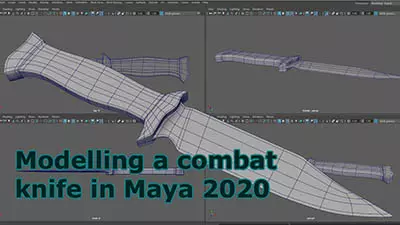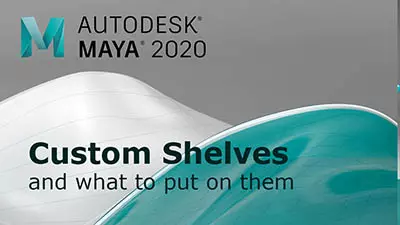Maya 2020 fundamentals - modelling the real world
Get halfway through a model and find it's an unworkable mess? Can't add edge loops where you need them? Can't subdivide a mesh properly? If any of this sounds familiar check this course out.
#
1
18-09-2011
, 09:20 PM
Registered User
Join Date: Jun 2008
Join Date: Jun 2008
Location: Los Angeles, CA
Posts: 229
Trouble with NURBS
I have the bulk of my object. A claw built out of multiple lofted elliptical-ish curves. Naturally, lofts end with a hole. I want to round that hole off, which means that Cap Nurbs and Lofting Final Iso to a zero-scale closed-curve (both cheats I've used before and hated the outcome) won't work. So I built this cage out of 3 curves. All points that seem to intersect DO intersect (snapped to curves).
1) I cannot, however, figure out how to make a surface on this VERY SIMPLE cage.
2) After that I'll loft the open surface area's iso to this cage's elliptical-ish curve. Will that work or is fillet the right tool for the final connection step?
Thanks!
--
Peter Srinivasan
Producer
#
2
18-09-2011
, 10:47 PM
So you would need to cut up your curves so that each patch will be a quad.
Take a look here for an example: https://www.creativecrash.com/tutoria...part-1-3/page2
Imagination is more important than knowledge.
#
3
18-09-2011
, 11:38 PM
Registered User
Join Date: Jun 2008
Join Date: Jun 2008
Location: Los Angeles, CA
Posts: 229
--
Peter Srinivasan
Producer
#
4
19-09-2011
, 12:30 AM
If I ever build something with curves, I'll loft them, then convert them to polys, and finish it off that way.
Imagination is more important than knowledge.
#
5
19-09-2011
, 12:35 AM
Registered User
Join Date: Jun 2008
Join Date: Jun 2008
Location: Los Angeles, CA
Posts: 229
--
Peter Srinivasan
Producer
#
6
19-09-2011
, 03:25 AM
This will create kind of a reshaped half nurbs sphere at the end of the surface. The down side to this is you will have a pole at each end.
Here is the idea...
The curves are numbered 1-8. The boundary surfaces are created by picking the curves in the order shown. (ie the top front surface is a boundary formed from curve 1, 2 and 4 (1-2-4). The order you select the boundary curves in is important the pole will be between the first two curves selected.
After creating the four surfaces (and rebuilding them) attach them to create a single surface.
"If I have seen further it is by standing on the shoulders of giants." Sir Isaac Newton, 1675
Last edited by ctbram; 19-09-2011 at 05:02 AM.
#
7
19-09-2011
, 03:28 AM
 I know a lot of people that use the lofting function, but they always finish up in polys.
I know a lot of people that use the lofting function, but they always finish up in polys.
Imagination is more important than knowledge.
Last edited by NextDesign; 19-09-2011 at 03:33 AM.
#
8
10-12-2011
, 02:57 AM
Registered User
Join Date: Dec 2011
Join Date: Dec 2011
Posts: 12
it's really about the modeling and editing process--do you need the accuracy of nurbs curves as you model? if not, modeling in polys will probably do you just fine. for rendering, its all poly when all is said and done
#
9
10-12-2011
, 05:23 AM
If properly implemented and maintained, which unfortunately they are not in Maya, they can be a very powerful tool. Especially for hard surface modeling. There is a very good reason why nurbs are used as the primary and in most cases only method to describe surfaces in automotive, aircraft, mechanical, and industrial design software and it is not simply because they are light weight. The precision and control one has using nurbs to build accurate complex compound surfaces far exceeds anything one could possible hope to achieve using polygons and a purely polygon modeling workflow.
There are complex surface shapes that would almost be impossible to model accurately without nurbs curves and surfaces. Other packages have splines and spline patches and nurms and in the case of 3ds max and modo and c4d and lightwave they are being not only maintained but enhanced because these companies have the foresightedness to realize their value.
For Autodesk and alias before them to ignore nurbs curves and surfaces for the last ten years is in my opinion is a major mistake and is very short sited. Were they to drop nurbs support entirely that would be the last straw for me and I would certainly switch to another modeling application.
"If I have seen further it is by standing on the shoulders of giants." Sir Isaac Newton, 1675
Last edited by ctbram; 12-12-2011 at 12:22 AM.
#
10
12-12-2011
, 12:17 AM
Registered User
Join Date: Dec 2011
Join Date: Dec 2011
Posts: 12
Last edited by LML; 12-12-2011 at 12:25 AM.
Posting Rules Forum Rules
Similar Threads
Separating lofted nurbs object from polygon?
by 3dscrub in forum Maya Basics & Newbie Lounge replies 1 on 08-04-2014
Free Friday Tutorial #7: Maya NURBS tips and tricks
by Nilla in forum SimplyMaya Tutorials replies 7 on 10-12-2011
Polygons v/s Nurbs
by Perfecto in forum Maya Basics & Newbie Lounge replies 10 on 22-07-2010
square nurbs or nurbs square?
by Binabik in forum Maya Basics & Newbie Lounge replies 7 on 07-03-2004
Your Getting on my last NURBS!!! he he he
by SuperDave71 in forum Maya Basics & Newbie Lounge replies 3 on 30-10-2002
Topics
New tutorial - Create tileable textures from photos. Photoshop to Alchemist to Maya 2
By David
Site News & Announcements
5
Free Courses
Full Courses
VFX News
How computer animation was used 30 years ago to make a Roger Rabbit short
On 2022-07-18 14:30:13
Sneak peek at Houdini 19.5
On 2022-07-18 14:17:59
VFX Breakdown The Man Who Fell To Earth
On 2022-07-15 13:14:36
Resident Evil - Teaser Trailer
On 2022-05-13 13:52:25
New cloud modeling nodes for Bifrost
On 2022-05-02 20:24:13
MPC Showreel 2022
On 2022-04-13 16:02:13









